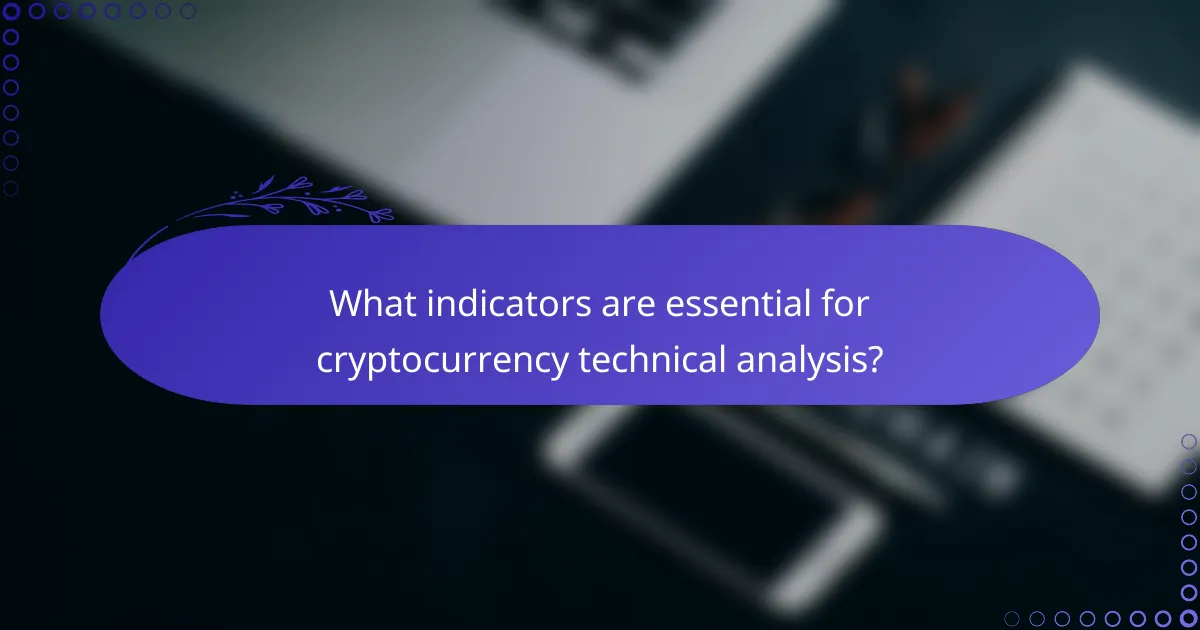Cryptocurrency technical analysis is crucial for traders seeking to navigate the volatile market effectively. By utilizing a variety of tools and indicators, traders can gain valuable insights into market trends and price movements, allowing for informed decision-making. Developing a solid trading strategy that incorporates these analytical tools is essential for managing risk and optimizing entry and exit points.

What are the best cryptocurrency technical analysis tools?
The best cryptocurrency technical analysis tools provide traders with essential data and insights to make informed decisions. These tools vary in features, usability, and pricing, catering to different levels of expertise and trading strategies.
TradingView
TradingView is a popular platform known for its user-friendly interface and extensive charting capabilities. It offers a wide range of technical indicators, drawing tools, and social features that allow traders to share insights and strategies.
With real-time data and customizable charts, TradingView supports various cryptocurrencies, making it suitable for both beginners and experienced traders. Users can access a free version, but premium subscriptions unlock additional features like advanced charting and more indicators.
Coinigy
Coinigy is a comprehensive trading platform that integrates with multiple cryptocurrency exchanges. It provides advanced charting tools, market data, and portfolio management features, allowing users to analyze trends across different markets.
One of Coinigy’s strengths is its ability to execute trades directly from the platform, streamlining the trading process. While it offers a free trial, ongoing use requires a subscription, which can be a consideration for budget-conscious traders.
MetaTrader 4
MetaTrader 4 (MT4) is primarily known for forex trading but is also applicable for cryptocurrency analysis. It features robust charting tools, automated trading capabilities, and a wide range of technical indicators.
MT4 is favored by traders who prefer algorithmic trading, as it allows for the creation of custom scripts and expert advisors. While it may have a steeper learning curve for beginners, its flexibility and depth make it a powerful tool for serious traders.
CryptoCompare
CryptoCompare is a data aggregator that provides comprehensive market information, including price charts, historical data, and news updates. It is particularly useful for traders looking to compare different cryptocurrencies and exchanges.
The platform offers various tools for technical analysis, including charting features and a portfolio tracker. CryptoCompare is free to use, making it an accessible option for traders at all levels.
ChartIQ
ChartIQ is a professional-grade charting library that focuses on providing advanced charting capabilities for financial markets, including cryptocurrencies. It is designed for developers looking to integrate high-quality charts into their applications.
With features like real-time data feeds and customizable indicators, ChartIQ is ideal for businesses and professional traders. However, it may not be the best choice for casual traders due to its complexity and pricing structure, which typically involves a licensing fee.

How to develop effective cryptocurrency trading strategies?
To develop effective cryptocurrency trading strategies, traders should focus on understanding market trends, price movements, and risk management. A well-defined strategy incorporates technical analysis tools and a clear plan for entry and exit points.
Trend following strategies
Trend following strategies involve identifying and capitalizing on market momentum. Traders typically use indicators like moving averages or the Relative Strength Index (RSI) to determine the direction of the trend and make buy or sell decisions accordingly.
For example, a trader might buy when the price crosses above a 50-day moving average and sell when it drops below. This approach can work well in strong trending markets but may lead to losses in sideways or choppy conditions.
Mean reversion strategies
Mean reversion strategies are based on the idea that prices will return to their average over time. Traders using this strategy look for overbought or oversold conditions, often indicated by Bollinger Bands or the RSI, to identify potential reversal points.
For instance, if a cryptocurrency’s price rises significantly above its historical average, a trader might short the asset, expecting a pullback. While this strategy can be effective in volatile markets, it requires careful timing and risk management to avoid false signals.
Breakout strategies
Breakout strategies focus on entering positions when the price breaks through established support or resistance levels. Traders often set buy orders above resistance or sell orders below support, anticipating significant price movements following the breakout.
For example, if a cryptocurrency has been trading in a range and breaks above a key resistance level, it may signal a strong upward trend. However, traders should be cautious of false breakouts, where the price quickly reverses after the initial movement.

What indicators are essential for cryptocurrency technical analysis?
Essential indicators for cryptocurrency technical analysis include tools that help traders assess market trends and potential price movements. These indicators provide insights into market conditions, enabling informed trading decisions.
Moving averages
Moving averages are widely used to smooth out price data and identify trends over specific periods. The two most common types are the Simple Moving Average (SMA) and the Exponential Moving Average (EMA), with the latter giving more weight to recent prices. Traders often look at the 50-day and 200-day moving averages to spot bullish or bearish signals.
When the short-term moving average crosses above the long-term moving average, it may indicate a buying opportunity, while the opposite crossover could signal a sell. However, moving averages can lag behind price movements, so they should be used in conjunction with other indicators.
Relative Strength Index (RSI)
The Relative Strength Index (RSI) measures the speed and change of price movements, providing insights into overbought or oversold conditions. It ranges from 0 to 100, with values above 70 typically indicating overbought conditions and values below 30 suggesting oversold conditions.
Traders often use the RSI to identify potential reversal points. For example, if the RSI is above 70 and starts to decline, it may be a signal to sell. Conversely, if the RSI is below 30 and begins to rise, it could indicate a buying opportunity. However, relying solely on the RSI can lead to false signals, so it’s best to combine it with other indicators.
Bollinger Bands
Bollinger Bands consist of a middle band (SMA) and two outer bands that represent price volatility. The distance between the bands expands and contracts based on market volatility, providing a visual representation of price levels relative to historical norms. When prices touch the upper band, it may indicate overbought conditions, while touching the lower band may suggest oversold conditions.
Traders often look for price breakouts when the bands narrow, signaling potential volatility. However, Bollinger Bands should not be used in isolation; combining them with other indicators can enhance their effectiveness in predicting price movements.
MACD
The Moving Average Convergence Divergence (MACD) is a trend-following momentum indicator that shows the relationship between two moving averages of a security’s price. It consists of the MACD line, signal line, and histogram, which help traders identify potential buy and sell signals based on crossovers and divergences.
A common strategy is to buy when the MACD line crosses above the signal line and sell when it crosses below. Additionally, traders look for divergences between the MACD and price movements to spot potential reversals. However, like other indicators, the MACD can produce false signals, so it is advisable to use it alongside other analysis tools for confirmation.

How to interpret cryptocurrency price charts?
Interpreting cryptocurrency price charts involves analyzing visual representations of price movements over time to make informed trading decisions. Key elements include understanding trends, patterns, and indicators that can signal potential price changes.
Candlestick patterns
Candlestick patterns are visual indicators on price charts that represent the open, high, low, and close prices within a specific time frame. Each candlestick provides insights into market sentiment, with patterns like bullish engulfing or shooting stars signaling potential reversals or continuations in price trends.
Traders often look for specific formations, such as dojis or hammers, to gauge market momentum. Recognizing these patterns can help traders make timely decisions, but it’s essential to consider them in conjunction with other analysis tools for better accuracy.
Support and resistance levels
Support and resistance levels are critical price points where the market tends to reverse direction. Support is the price level where buying interest is strong enough to overcome selling pressure, while resistance is where selling interest prevails over buying. Identifying these levels can help traders set entry and exit points.
To determine support and resistance, traders often look at historical price data, trend lines, and moving averages. A common strategy is to buy near support levels and sell near resistance levels, but it’s crucial to remain cautious of potential breakouts that can lead to significant price movements.
Volume analysis
Volume analysis involves examining the number of assets traded during a specific period to gauge the strength of price movements. High trading volume typically indicates strong interest and can confirm trends, while low volume may suggest weak price action or potential reversals.
Traders often use volume indicators, such as the Volume Weighted Average Price (VWAP), to assess whether price movements are supported by sufficient trading activity. A sudden increase in volume can signal a breakout or breakdown, making it a vital component of technical analysis in cryptocurrency trading.

What are the prerequisites for successful cryptocurrency trading?
Successful cryptocurrency trading requires a solid understanding of market fundamentals, technical analysis, and risk management strategies. Traders should also be familiar with the tools and platforms available for trading, as well as the regulatory environment in their respective countries.
Understanding market fundamentals
Market fundamentals refer to the underlying factors that influence the value of cryptocurrencies. This includes supply and demand dynamics, market sentiment, and macroeconomic indicators. Understanding these elements helps traders make informed decisions about when to buy or sell.
Key factors to consider include the total supply of a cryptocurrency, its adoption rate, and the overall health of the blockchain technology it operates on. For instance, a cryptocurrency with a capped supply may experience price increases as demand grows, while those with unlimited supply may struggle to maintain value.
Traders should also keep an eye on news events and regulatory changes that can impact the market. For example, announcements from major exchanges or government regulations can lead to significant price volatility. Staying updated on these developments is crucial for effective trading.
